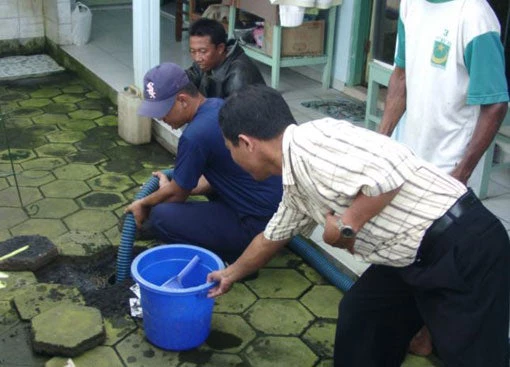
Communities in Indonesia have a saying about toilets: “a good sanitation system is a large leaking tank that will never need emptying.” That is because most septic tanks are built under a concrete tank cover, often inside the house or directly under the toilet, without access to lids or manholes. They often do not require emptying for many years.
However, a study conducted in 2013 by the World Bank Group’s Water and Sanitation Program (WSP) showed that 83% of on-site sanitation facilities in urban areas – where toilets and the septic tank are in the same location – leak fecal-contaminated waste to the ground through the use of non-standard septic tanks.
Other misconceptions have made it difficult to establish good toilet systems in cities.
The Philippines, with similar challenges and opportunities in improving the quality of urban sanitation service, is a good place for Indonesia to learn from on implementing a regular desludging program to drain and clean tanks including the importance of linking desludging with improving on-site sanitation efforts. Due to frequent reluctance and even resistance by customers who own ‘non-standard’ septic tanks, many customers do not see the benefits of regular desludging and have reverted to an on-call (or on-demand) system.
An on-call system, which only serves selected houses, disregards the fact that every household could potentially pollute their environment. And, the on-call system also relates with the payment and monitoring system which can bring a higher possibility of dispose the sludge at unsuitable treatment plants.
Only recently have regular desludging of septic tanks started in Indonesia, in cities like Jakarta, Balikpapan, Tabanan, Solo, Bandung, Bogor and Makassar. To avoid the reversion of regular desludging into an on-call system, the government needs to align the implementation of regular desludging with improving on-site sanitation.
To explore how on-site sanitation systems can be improved, WSP undertook household surveys in six cities across Indonesia to identify challenges and opportunities. The surveys were carried out in poor dense urban communities using on-site sanitation.
The study found that the management of sanitation facilities is shared by different departments, which leads to gaps and unclear responsibilities. For example, planning departments require a septic tank to be shown on housing construction plans, but often do not provide guidance, regulation, or inspection. Local governments tend to focus on municipal infrastructure, in particular construction of new septage treatment plants. This is partly due to the lack of funding for improving on-site sanitation facilities, and the common perception that government is restricted from investing in infrastructure on private property.
During the survey, communities offered their own ideas. Although they are not experts in septic tanks, communities know their environment. Some families understood the risks they face, such as groundwater contamination and overflowing polluted drainage in dense areas. Communities were also willing to pay to improve their on-site sanitation facilities, although perhaps not enough to cover the full cost.
From house to treatment, the sanitation service chain could improve if it is regulated, serviced, and monitored, at both the national and local level. Government responsibilities should be clarified and enforced. The central government could use local preparedness as criteria for local governments receiving investment support.
An incentives program for families to upgrade their on-site sanitation systems would help, and one for local governments to carry out regular desludging. Public awareness of what constitutes a good septic tank should be heightened, through targeted and timely promotion campaigns. Local leaders should be involved to help convince communities of the benefits.
Do you have any experience in improving toilets aligned with regular desludging of septic tanks? Please tell us in the comments section, we’d certainly be interested to know.


Join the Conversation